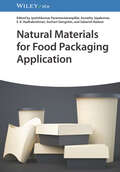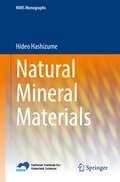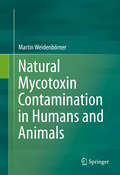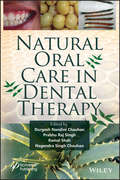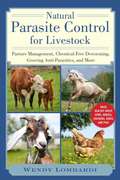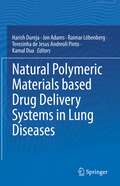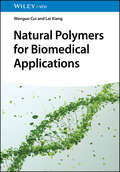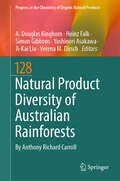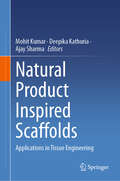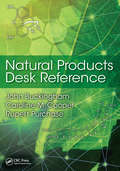- Table View
- List View
Natural Materials for Food Packaging Application
by Jyotishkumar Parameswaranpillai; Aswathy Jayakumar; E. K. Radhakrishnan; Suchart Siengchin; Sabarish RadoorNatural Materials for Food Packaging Application Analyze the future of biodegradable food packaging with this cutting-edge overview Packaging plays an essential role in the production of food and its movement through the global supply chain. Food packaging has been a significant site of innovation recently, allowing consumers better access to natural and organic foods, extended shelf lives, and more. However, food packaging has become an increasingly serious environmental hazard, with the result that biodegradable food packaging has become a vital and growing area of research. Natural Materials for Food Packaging Application provides a thorough and detailed introduction to natural packaging and its applications in food transportation. Treating both recent innovations and prospective future developments, it provides readers with extensive insights into the current state of research in this field. The result is a volume designed to meet the aspirational needs of a sustainable food industry. Natural Materials for Food Packaging Application readers will also find: Detailed treatment of biodegradable packaging materials including thermo-plastic starch, polybutylene succinate, and more Discussion of subjects including chitosan-based food packaging films, clay-based packaging films, and more An authorial team with vast expertise in the field of biological polymer production Natural Materials for Food Packaging Applications is a useful reference for chemists, materials scientists, and food scientists, as well as for any industry professionals working in food distribution and the food supply chain.
Natural Mineral Materials (NIMS Monographs)
by Hideo HashizumeThis book presents natural minerals used as inorganic materials, and inorganic materials exchanging cations or anions in natural minerals for other ions not found in nature. In addition, composites such as natural mineral materials that interact with organic molecules or polymers are introduced according to how they are used.Readers can refer to this volume as a guidebook to search for specific inorganic materials, and, if they wish, can consult any part of it at random. The book will be especially helpful and of interest to both scientists and engineers.
Natural Mycotoxin Contamination in Humans and Animals
by Martin WeidenbörnerThis book presents a review of the existing literature on natural mycotoxins to create a comprehensive reference for mycotoxin levels. Each entry includes contamination, concentration rate, mostly mean mycotoxin concentration of organs (human and animal) and country of origin of the sample. Due to the serious spoilage and health issues the presence of mycotoxins can cause, it is imperative that corresponding scientists, health institutions and the food and feed industries have a more qualified understanding of mycotoxins in living things. To this end, Natural Mycotoxin Contamination in Humans and Animals provides an excellent resource. The present book complements the series of the author's previous books, Mycotoxins in Feedstuffs and Mycotoxins in Foodstuffs, in that it is a review of the literature to create a comprehensive reference for mycotoxin levels. As with Mycotoxins and their Metabolites in Humans and Animals, the focus remains the same, but the scope now covers natural mycotoxins only. Comprehensive reference of natural mycotoxin levels in humans and animals Easy-to-use database of mycotoxins Each entry is comprehensive
Natural Neuroscience: Toward a Systems Neuroscience of Natural Behaviors
by Nachum UlanovskyA new approach to brain research that emphasizes studying the brain under naturalistic conditions.Natural neuroscience departs from the classical reductionist approach, which emphasizes control at the expense of natural behaviors, by proposing a shift toward real-world relevance, natural behaviors, and ecological validity. In Natural Neuroscience, Nachum Ulanovsky presents the conceptual, empirical, and technological underpinnings that enabled this new field. Natural neuroscience researchers posit that when studying any brain region in any animal, whether standard mammalian species such as rodents and primates or nonstandard species, it is crucial to pursue the animal&’s natural behaviors and to consider the natural problems it needs to solve. By preventing rich natural behaviors, says Ulanovsky, we miss key aspects of brain function—and we may not even know what we miss.The author surveys recent studies that have begun to move in this direction across multiple subfields of neuroscience, including sensory, cognitive, social, and behavioral neuroscience. He discusses technological advances that are allowing the pursuit of more naturalistic experiments, including methods for recording neural activity in freely behaving, freely moving animals (e.g., wired and wireless electrophysiology and imaging); methods for manipulating neural activity in freely moving animals (e.g., wired and wireless optogenetics); and methods for quantifying the details of behavior. He makes connections across the four major scientific disciplines that focus on understanding behavior—neuroscience, behavioral ecology, ethology, and psychology—bringing them closer together, and closer to real life.
Natural Obsessions: Striving to Unlock the Deepest Secrets of the Cancer Cell
by Natalie AngierThis classic work of science writing chronicles the search for the origins of cancer—with a new introduction by the Pulitzer Prize–winning author.In Natural Obsessions, acclaimed science writer Natalie Angier holds a microscope up to the agony and ecstasy of scientific research. Angier spent close to a year observing the work of two prominent biologists—MIT’s Robert Weinberg and Michael Wigler of the Cold Spring Harbor Laboratory—as they each doggedly pursue the mysteries of the cancer cell. Delving into the drama of scientific inquiry, Angier captures life inside the lab, opening a rare window into how scientists think, feel, and behave.Originally published in 1988, this edition of Natural Obsessions includes a new introduction by Angier as well as a foreword by the physician, poet, and author Lewis Thomas.
Natural Obsessions: The Search for the Oncogene
by Lewis Thomas Natalie AngierThe discovery of these genes and their role in human malignancy has been one of the most dramatic events in biology in the late twentieth century. In this book, Angier describes scientist Bob Weinberg, his research lab, and the dozens of scientists who work towards understanding the oncogene. She describes the dynamic of the lab and its workers as well as the details of each gene experiment.
Natural Or Man-Made? (My Science Library)
by Kelli HicksIntermediate Readers Distinguish Between Natural And Man-Made Objects.
Natural Oral Care in Dental Therapy
by Durgesh Nandini Chauhan Nagendra Singh Chauhan Prabhu Raj Singh Kamal ShahBecause of increasing antibiotic resistance, stronger antibiotics are reserved for serious active infection, paving the way for a greater use of herbal antibiotics. This book helps dentists in implementing safe and effective natural medicine therapies to complement the current practice guidelines. Oral diseases continue to be a major health problem world-wide. Oral health is integral to general well-being and relates to the quality-of-life that extends beyond the functions of the craniofacial complex. The standard Western medicine has had only limited success in the prevention of periodontal disease and in the treatment of a variety of oral diseases. The dentist needs to be more informed regarding the use, safety and effectiveness of the various traditional medicines and over-the-counter products. Herbal extracts have been used in dentistry for reducing inflammation, as antimicrobial plaque agents, for preventing release of histamine and as antiseptics, antioxidants, antimicrobials, antifungals, antibacterials, antivirals and analgesics. They also aid in healing and are effective in controlling microbial plaque in gingivitis and periodontitis and thereby improving immunity. The 26 chapters in this unique book explore all the measures to utilize the natural oral care obtained from plants, animals and mineral drugs for dental care.
Natural Parasite Control for Livestock: Pasture Management, Chemical-Free Deworming, Growing Antiparasitics, and More
by Wendy LombardiEverything You Need to Know about Natural Parasite Control for Livestock, All in One Place! This concise book is loaded with valuable information about ridding livestock of their unwanted guests. Whether you're raising sheep, pigs, horses, cows, chickens, goats, or other farm animals, this book will teach you how to keep them healthy and parasite-free through organic systems and without the use of harsh chemicals. It includes easy-to-follow scientific explanations, and provides research-based practices that really work. Internal parasite control can be accomplished naturally 1) through environmental modifications, 2) by producing and using easy-to-grow & harvest anti-parasitics, and, 3) by understanding the life-cycles and road blocks of internal parasites. In this practical guide you will learn about: Parasites, hosts, and lifecyclesHow to develop a working pasture rotation systemHow to create healthy pastures and clean watering systemsAdministering natural antiparasiticsGrowing, collecting, and processing natural and herbal antiparasiticsAnd more! This is a necessary reference manual for all sustainable, natural, animal-husbandry endeavors!
Natural Polymeric Materials based Drug Delivery Systems in Lung Diseases
by Jon Adams Kamal Dua Raimar Löbenberg Harish Dureja Terezinha de Jesus Andreoli PintoThis book comprehensively reviews the recent developments of natural polymers for drug delivery systems in various lung disorders. The initial chapter provides a brief introduction to lung diseases with a focus on the current landscape of natural polymers and trends in understanding the disease pathology. Several chapters of the book devoted to the latest technologies and advances in drug delivery systems include practical solutions on designing more effective drug delivery systems based on natural polymers that can be used in the management of lung diseases. Further, the book presents biodegradable and bio-reducible- natural polymers- based drug delivery systems for lung diseases. Towards the end, the book examines future prospects and challenges of natural polymers-based drug delivery systems in combating lung diseases. This book is useful for phytochemists, formulation/drug delivery, biological and translational researchers and clinicians working in the field of lung disorders.
Natural Polymers for Biomedical Applications
by Wenguo Cui Lei XiangDevelop natural solutions to biomedical problems with this introduction A natural polymer is one that forms from biosynthetic or biochemical processes typically found in nature, with corresponding advantages in biocompatibility and biodegradability. These advantages give natural polymers a range of applications, from the use of polysaccharides as structural components to the use of polyphenols as antioxidant active ingredients. In biomedical engineering they are clearly preferable to synthetic polymers in numerous cases, and their applications are more numerous every day. Natural Polymers for Biomedical Applications offers a comprehensive summary of these polymers and their biomedical applications. It covers the sources, structures, and properties of polysaccharides, polyphenols, and polypeptides, as well as analyzing the latest advances in polymer-based biomedical technologies. The result has ramifications in a vast range of industries and research areas. In Natural Polymers for Biomedical Applications readers will also find: Applications including drug and cell delivery, cell and organoid cultures, tissue regeneration, and moreDetailed analysis of alginate, cellulose, quercetin, silk fibroin, and many othersA logical, easy-to-use structure to facilitate rapid access to pertinent information Natural Polymers for Biomedical Applications is ideal for materials scientists, polymer chemists, biochemists, and any researcher or professional in biomedical or pharmaceutical industries.
Natural Polymers for Drug Delivery
by Ram Prasad Neerupma Dhiman Monika Joshi Deepshikha Pande Katare Wong Tin Wui Anirbandeep Bose Ali Demir Sezer Erdal CevherNatural polymers have been utilized extensively in food, pharmaceuticals, cosmetics, textiles, oil drilling and paint industries. Their non-toxic and inexpensive attributes readily enhance their commercial acceptability and make them potent agents in lieu of synthetic polymers. This book explores the opportunistic utility of natural polymers in developing effective drug delivery systems and provides a comprehensive and up-to-date analysis of their source, chemical structure and mechanism of action. Covering novel polymers for drug delivery - in particular extracts from plants, microorganisms and proteins, as well as water soluble and water insoluble biodegradable polymers - it presents an encyclopaedic overview of natural polymers': - quintessential roles in binding drugs towards enhancing bioavailability - modification and derivatization for targeted delivery - role as active drugs Natural Polymers for Drug Delivery is an invaluable resource for researchers, students and industrial scientists in the fields of biochemistry, chemistry, pharmacology and food science.
Natural Product Based Drug Discovery Against Human Parasites: Opportunities and Challenges
by Archana Singh Indrakant K. Singh Brijesh Rathi Anita K. VermaThis book comprehensively reviews current and novel treatment strategies against human parasites, including protozoans and helminths, using natural products. The initial chapters summarize the conventional treatment strategies and natural-product based therapeutics against these parasites. It discusses biochemical tools and techniques for the discovery of natural product based drugs against human parasites. The book also covers the ingenious and innovative mechanisms to achieve drug resistance by the protozoan parasites and strategies to overcome the resistance. It entails mechanistic insight into the modulation of host immune responses to delay or inhibit parasite clearance and explores host-pathogen interactions that mediate immunity against subsequent parasite challenge. In turn, the volume helps in understanding the immunobiology of the parasites and tools to identify candidate vaccine antigens and novel delivery systems against the protozoan parasites. Lastly, it explores the role of advanced methods, including nanotechnology, marine bioprospecting, and microorganisms-derived biochemicals against the protozoan parasites.This book is useful for students and researchers of pharmacology, parasitology, zoology and other allied fields.
Natural Product Diversity of Australian Rainforests (Progress in the Chemistry of Organic Natural Products #128)
by A. Douglas Kinghorn Heinz Falk Simon Gibbons Yoshinori Asakawa Ji-Kai Liu Verena M. DirschThe book reviews the natural product chemistry of Australian rainforest plants, with a particular focus on their fascinating phylogenetic relationships. It discusses the unique flora of Australia, which is of Gondwanan origin, and how this has led to a diverse range of natural products. The text explores the chemical constituents of various plant groups, including those of gymnosperms, basal angiosperms, magnoliids, monocots, and eudicots, with an emphasis on the Australian rainforest species. Key points covered include the historical context of Australian flora, its high level of endemism, and the impact of past climatic changes on rainforest distribution. The book also details the specific phytochemicals found in these plants (about 2,400), such as alkaloids, lignans, and terpenoids, and their biological activities. Overall, this comprehensive volume highlights the importance of Australian rainforests as a rich source of unique natural products and emphasizes the need for further research in this area, in particular given that only approximately 10% of these rainforest species have been investigated so far.
Natural Product Experiments in Drug Discovery (Springer Protocols Handbooks)
by Xuefei Yang Karuppusamy Arunachalam Sreeja Puthanpura SasidharanThis detailed volume explores a wide range of evidence-based complementary medicine and various bio-analytical techniques used to define botanical products. Collecting recent work and current developments in the field of contemporary phytomedicine as well as their future possibilities in human health care, the book includes unique contributions in the form of chapters on phytomedicine and screening biological activities explained with diverse hyphenated techniques, as well as issues related to herbal medications, such as efficacy, adulteration, safety, toxicity, regulations, and drug delivery. Written for the Springer Protocols Handbooks series, chapters feature advice from experts on how to best conduct future experiments. Extensive and practical, Natural Product Experiments in Drug Discovery serves as an ideal reference for students, professors, and researchers in universities, R&D institutes, pharmaceutical and herbal enterprises, and health organizations.
Natural Product Inspired Scaffolds: Applications in Tissue Engineering
by Ajay Sharma Mohit Kumar Deepika KathuriaThe book explains the use of natural products as scaffolds in tissue engineering. It presents an introduction to the concept of natural product-based scaffolds and explores various fabrication strategies for their synthesis. The book highlights the wide range of applications of these scaffolds in tissue engineering, including their use in tissue regeneration, wound healing, plastic surgery, and breast reconstruction. Specific natural products, such as gums (xanthan, gellan, arabic, guar, ghatti gum), chitosan, collagen are discussed in separate chapters. In addition, various application of natural product loaded PCL and PLA scaffolds have also been discussed. Each chapter focuses on the application of these natural product based scaffolds and explores their potential in tissue engineering. It also covers specific applications of these scaffolds in tissue regeneration, including angiogenesis, bone, skin, and nerve tissue regeneration. The book addresses important considerations regarding the toxicity and regulatory aspects of natural product-based scaffolds and explores the challenges associated with their implementation and emphasizes the need for safety and compliance in their use. Overall, the book provides a comprehensive overview of the field. It serves as a valuable resource for researchers, scientists, and professionals in the field of tissue engineering.
Natural Product Isolation and Identification: Methods and Protocols (Methods in Molecular Biology #2895)
by Young Hae Choi Özlem Erol Sandra IrmischThe purpose of this book is to provide guidance in the process of extraction, separation, and identification of natural products. Chapters guide readers through HPLC, GC, NMR, TLC, deep eutectic solvents, chemical elucidation of individual groups of metabolites, phenolics, coumarins, lignans, saponins, and their integration with a biological model. Written in the highly successful Methods in Molecular Biology series format, chapters include introductions to their respective topics, lists of the necessary materials and reagents, step-by-step, readily reproducible laboratory protocols, and tips on troubleshooting and avoiding known pitfalls. Authoritative and cutting-edge, Natural Product Isolation and Identification: Methods and Protocols aims to be a reference guide for natural products researchers or researchers beginning practical work in the natural products field.
Natural Products
by Rebecca Goss Guy T. Carter Anne OsbournNatural Products: Discourse, Diversity and Design provides an informative and accessible overview of discoveries in the area of natural products in the genomic era, bringing together advances across the kingdoms. As genomics data makes it increasingly clear that the genomes of microbes and plants contain far more genes for natural product synthesis than had been predicted from the numbers of previously identified metabolites, the potential of these organisms to synthesize diverse natural products is likely to be far greater than previously envisaged. Natural Products addresses not only the philosophical questions of the natural role of these metabolites, but also the evolution of single and multiple pathways, and how these pathways and products may be harnessed to aid discovery of new bioactives and modes of action. Edited by recognized leaders in the fields of plant and microbial biology, bioorganic chemistry and natural products chemistry, and with contributions from researchers at top labs around the world, Natural Products is unprecedented in its combination of disciplines and the breadth of its coverage. Natural Produces: Discourse, Diversity and Design will appeal to advanced students and experienced researchers, from academia to industry, in diverse areas including ecology, industrial biotechnology, drug discovery, medicinal chemistry, agronomy, crop improvement, and natural product chemistry.
Natural Products Analysis
by Jaroslav Spizek Vladimir HavlicekThis book highlights analytical chemistry instrumentation and practices applied to the analysis of natural products and their complex mixtures, describing techniques for isolating and characterizing natural products.* Applies analytical techniques to natural products research - an area of critical importance to drug discovery* Offers a one-stop shop for most analytical methods: x-ray diffraction, NMR analysis, mass spectrometry, and chemical genetics* Includes coverage of natural products basics and highlights antibacterial research, particularly important as efforts to combat drug resistance gain prominence* Covers instrumental techniques with enough detail for both current practitioners and beginning researchers
Natural Products Chemistry of Botanical Medicines from Cameroonian Plants (Natural Products Chemistry of Global Plants)
by Xavier Siwe-NoundouA contribution to the series on Natural Products Chemistry of Global Plants, Natural Products Chemistry of Botanical Medicines from Cameroon focuses on the sources and chemistry of natural products from plants in Cameroon, West Africa. The plants selected offer an opportunity to trace a route through history from ancient civilizations to the modern day, showing the important value to man of natural products in medicines and in foods. This book highlights how many of the extracts from Cameroon are today associated with important drugs, nutrition products, beverages, perfumes, cosmetics and pigments, as well as presenting their complex chemistry and structure. Key Features: Forms an important part of the series on Natural Products Chemistry of Global Plants, as Cameroon is a country with rich experience in the use of medicinal plants and with a wide diversity of botanical resources Addresses the current development of pharmacognosy research in Cameroon Provides readers with updated information on the chemistry and pharmacology of natural products with pharmaceutical potential Covers an extensive range of chemical, botanical and pharmacological diversities Xavier Siwe Noundou is a Scholar/Scientist based at Rhodes University in Grahamstown, South Africa. He has been a EU FP7 Marie Curie Fellow (2015-2016), Kaposvar University in Hungary (2015, 2016), Trakia Univesity in Bulgaria (2016), TWAS Fellow (2013), National Research Foundation South Africa Fellow (2014-2016). Dr Noundou works on Medicinal Chemistry focusing on Chemistry, Pharmacognosy and Nanotechnology. His main research interests include terrestrial natural products chemistry (from Cameroon and South Africa) and marine natural products chemistry (from the South African coastline): bioactive metabolites isolated as potential antiparasitic, antimicrobial, antiviral and antiproliferative candidates. He is author of more than forty scientific publications in his field of expertise.
Natural Products Chemistry: Sources, Separations and Structures
by Raymond Cooper George NicolaNotoriously cumbersome to isolate and challenging to synthesize, the path of natural products to viable drugs is an arduous journey. Yet compounds isolated from nature may possess fascinating structures, biological profiles and pharmaceutical potential far greater than anything made by man. Natural Products Chemistry: Sources, Separations and
Natural Products Desk Reference
by Rupert Purchase John Buckingham Caroline M. CooperWritten by a group of experts affiliated with the prestigious Dictionary of Natural Products, this book provides a concise overview of the key structural types of natural products and their interrelationship. A structurally diverse group, ranging from simple aliphatic carbon chains to high molecular weight proteins, natural products can usually be classified into one or more groups. The text describes these major types, including flavonoids, carbohydrates, terpenoids, polyketides, and lipids, and it illustrates them with accurate chemical structures, demonstrating the biosynthetic relationships between groups. The book also covers nomenclature, stereochemistry, and ring numbering.
Natural Products From Marine Algae
by Dagmar B. Stengel Solène ConnanThis volume provides a fundamental overview of the current state of the art in natural products from marine algae, linking the complex and diverse natural resource with recent developments in extraction, analytical and bioactivity testing methodologies. Natural Products from Marine Algae: Methods and Protocols guides readers through protocols and techniques on algal biotechnology, metabolites, Solid-Liquid Extraction (SLE), Microwave Assisted Extraction (MAE), Liquid Chromatography, Gas Chromatography, Nuclear Magnetic Resonance Spectroscopy, Infra-red spectroscopy and Raman Spectroscopy. Written in the highly successful Methods in Molecular Biology series format, chapters include introductions to their respective topics, lists of the necessary materials and reagents, step-by-step, readily reproducible laboratory protocols and tips on troubleshooting and avoiding known pitfalls. Authoritative and cutting-edge, Natural Products from Marine Algae: Methods and Protocols hopes to aid scientists unravel and quantify algal chemical diversity and support further marine biotechnological developments.
Natural Products Interactions on Genomes (Clinical Pharmacognosy Series)
by Siva G. SomasundaramFoods from natural products are a major contributor to contemporary dietary needs. The knowledge of interactions of specific natural products on genes is accumulating due to recent scientific advancements. Natural Products Interactions on Genomes focuses on recent developments in understanding human genome interactions with various natural products
Natural Products Isolation
by Lutfun Nahar Satyajit D. SarkerWith significant developments in the areas of chromatography and spectroscopy as well as the unique inherent chemical diversity of natural products, vital in drug research, natural products research has gained new momentum. Fully updating and adding to the previous two editions, Natural Products Isolation, Third Edition documents the latest methods and technologies for natural products isolation with a combination of all new chapters and revised and expanded classic methods. Written in the highly successful Methods in Molecular BiologyTM series format, chapters include introductions to their respective topics, lists of the necessary materials and reagents, step-by-step, readily reproducible laboratory protocols, and expert tips on troubleshooting and avoiding known pitfalls. Authoritative and up-to-date, Natural Products Isolation, Third Edition provides the substantial background information needed by budding natural product researchers as well offering an invaluable reference guide to available methodologies and techniques for the more experienced researchers.
